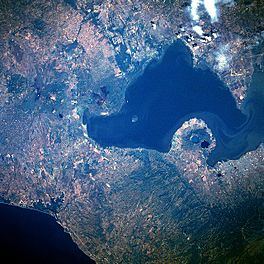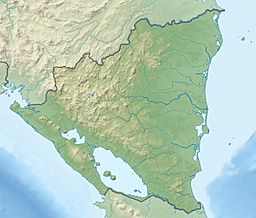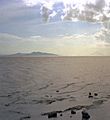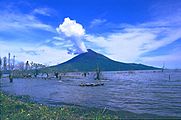Lake Managua facts for kids
Quick facts for kids Lake Managua |
|
|---|---|

1986 (north is to the left)
|
|
| Coordinates | 12°20′N 86°25′W / 12.333°N 86.417°W |
| Native name | |
| Basin countries | Nicaragua |
| Max. length | 65 km (40 mi) |
| Max. width | 25 km (16 mi) |
| Surface area | 1,024 km2 (395 sq mi) |
| Average depth | 9.5 m (31 ft) |
| Max. depth | 20 m (66 ft) |
| Surface elevation | 39 m (128 ft) |
| Islands | Momotombito |
| Settlements | Managua |
Lake Managua (also called Lago de Managua in Spanish), is a large lake in Nicaragua. It is also known as Lake Xolotlán. This lake is about 65 kilometers (40 miles) long and 25 kilometers (16 miles) wide. Its total area is about 1,024 square kilometers (395 square miles). The name Xolotlán comes from an old language called Nahuatl. The city of Managua, which is the capital of Nicaragua, is located on the southwestern side of the lake.
Islands in Lake Managua
Lake Managua has two islands. These islands do not have people living on them.
- Momotombito is an island that was formed by a volcano. There is another volcano nearby on the mainland called Momotombo.
- Isla Rosa is a smaller island.
Lake Flooding
The water level of Lake Managua can rise a lot when there is heavy rain. The highest water level ever recorded was during a big flood in 1933.
In 1998, during Hurricane Mitch, the lake's water level rose by 3 meters (10 feet) in just five days. This caused damage to the homes of many people who lived near the lake. An even bigger flood happened in September and October of 2010. After this, the city decided that people could not build homes in the areas most likely to flood. These are areas below 42.76 meters (140 feet) above sea level.
Lake Pollution
Some people have said that Lake Managua is "the most polluted lake in Central America." For many years, waste from the city's sewers was dumped directly into the lake. This started in 1927.
A modern plant to clean wastewater was opened in Managua in 2009. This plant was built and is run by a British company called Biwater. However, it only cleans about 40% of the city's wastewater.
The lake does not have a steady way for water to flow out. Sometimes, during floods, water flows into Lake Nicaragua through the Tipitapa River. Because the water doesn't flow out much, the pollution stays in the lake. Even with the pollution, some people in Managua still live by the lake and eat fish from it.
In 2007, an area called the malecón was cleaned. Mud from the lake bottom was removed using barges. This helped get rid of a strong smell that used to be in the area. A new stone and concrete dock was built. There is also a sightseeing boat called La Novia de Xolotlán that takes tourists on short trips around the lake.
Wildlife in the Lake
About 20 different kinds of fish still live in Lake Managua.
Even though Lake Managua is connected to Lake Nicaragua, bull sharks from Lake Nicaragua cannot swim into Lake Managua. This is because there is a 12-foot (3.7-meter) high waterfall on the Tipitapa River that blocks their path.
Gallery
-
Lake view from Tipitapa (2003)
-
View from Tipitapa (2003). Momotombo and Momotombito Volcanoes in the background
See also
 In Spanish: Lago Xolotlán para niños
In Spanish: Lago Xolotlán para niños





